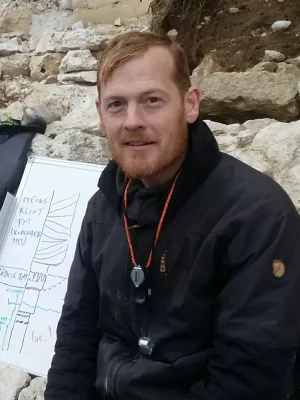
Mikael Calner
Professor

Integrated Cambrian biostratigraphy and carbon isotope chemostratigraphy of the Grönhögen-2015 drill core, Öland, Sweden
Författare
Summary, in English
The Grönhögen-2015 core drilling on southern Öland, Sweden, penetrated 50.15 m of Cambrian Series 3, Furongian and Lower–Middle Ordovician strata. The Cambrian succession includes the Äleklinta Member (upper Stage 5) of the Borgholm Formation and the Alum Shale Formation (Guzhangian–Tremadocian). Agnostoids and trilobites allowed subdivision of the succession into eight biozones, in ascending order: the uppermost Cambrian Series 3 (Guzhangian) Agnostus pisiformis Zone and the Furongian Olenus gibbosus, O. truncatus, Parabolina spinulosa, Sphaerophthalmus? flagellifer, Ctenopyge tumida, C. linnarssoni and Parabolina lobata zones. Conspicuous lithologic unconformities and the biostratigraphy show that the succession is incomplete and that there are several substantial gaps of variable magnitudes. Carbon isotope analyses (δ13Corg) through the Alum Shale Formation revealed two globally significant excursions: the Steptoean Positive Carbon Isotope Excursion (SPICE) in the lower–middle Paibian Stage, and the negative Top of Cambrian Excursion (TOCE), previously referred to as the HERB Event, in Stage 10. The δ13Corg chemostratigraphy is tied directly to the biostratigraphy and used for an improved integration of these excursions with the standard agnostoid and trilobite zonation of Scandinavia. Their relations to that of coeval successions in Baltoscandia and elsewhere are discussed. The maximum amplitudes of the SPICE and TOCE in the Grönhögen succession are comparable to those recorded in drill cores retrieved from Scania, southern Sweden. The results of this study will be useful for assessing biostratigraphic relations between shale successions and carbonate facies on a global scale.
Avdelning/ar
- Berggrundsgeologi
Publiceringsår
2019
Språk
Engelska
Sidor
935-949
Publikation/Tidskrift/Serie
Geological Magazine
Volym
156
Issue
06
Dokumenttyp
Artikel i tidskrift
Förlag
Cambridge University Press
Ämne
- Geology
Nyckelord
- agnostoids
- Alum Shale Formation
- Borgholm Formation
- carbon isotope excursion
- Scandinavia
- trilobites
Status
Published
ISBN/ISSN/Övrigt
- ISSN: 0016-7568

